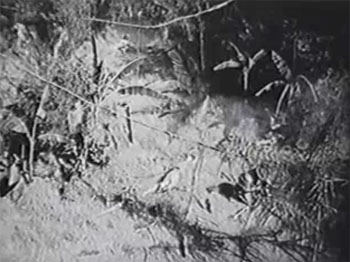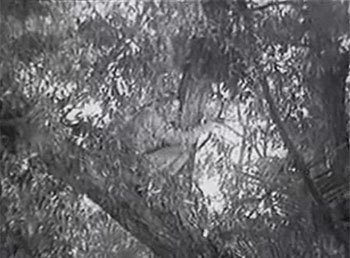
Mascot, 12 Chapters, 1935. Starring Grant Withers, Adrian Morris, Anne Rutherford, Robert Warwick, Tom London, Warner Richmond, J. Frank Glendon, Robert Frazer, George J. Lewis.
The US Marines are trying to establish a base on a Pacific isle called Halfway Island, but their attempts are being stymied by a mysterious force that causes airplanes to crash when they approach the island. The man behind these disasters is a mysterious modern-day pirate called The Tiger Shark, who uses Halfway Island as a base of operations and is determined to keep intruders out. However, the villain hasn’t reckoned on the tenacity of Corporal Lawrence (Grant Withers) and Sergeant MacGowan (Adrian Morris); these two Fighting Marines will eventually break the Tiger Shark’s hold on Halfway Island, with help from their brothers-in-arms.
The Fighting Marines was Mascot Pictures’ final serial; as it was reaching theaters, Mascot was joining other studios in a merger that would give birth to Republic Pictures. Even before the merger, however, alterations were being made to Mascot’s serial template; while Marines features one of the studio’s trademark mystery villains, its plot is nevertheless much less convoluted and more logical than those of most of its predecessors. This emphasis on simpler storytelling would carry over into Republic’s serials and remain standard policy throughout the new studio’s run as a chapterplay-maker.
Marines’ streamlined approach to plotting has both good and bad points; the lack of inexplicably villainous behavior by innocent suspects is refreshing–but, on the other hand, the suspect characters are much duller than the outrageous but colorful red herrings seen in Mascot outings like The Three Musketeers. The suspect pool, which features only two active members, is also severely reduced in size when compared to those in other Mascot cliffhangers.

Above: The red herrings: rival transportation moguls Buchanan (Frank Glendon, left) and Douglas (Robert Frazer).
The writers of Fighting Marines (Sherman Lowe, Barney Sarecky, Wallace MacDonald, Ray Trampe, and Maurice Geraghty) make some other questionable decisions; Marine Sgt. Schiller’s (George J. Lewis) “gyro-compass” is set up as an important MacGuffin in the first chapter, but the invention abruptly drops out of sight when its inventor is killed off a third of the way through the serial. Schiller’s sister Frances (Anne Rutherford), the chapterplay’s designated heroine, also vanishes from the proceedings at the halfway point. The early exit of the Schillers and the dropping of the gyro-compass subplot, along with the scarcity of suspects already mentioned, throws more strain on the already thin main plot (the battle for Halfway Island) and forces the writers to pad their narrative with several flashback sequences in multiple episodes.
That said, The Fighting Marines moves very swiftly, and blunts the repetitiveness of the Marines-Tiger Shark duel by continually moving its heroes between the island and the United States, which allows car chases and other urban action scenes to alternate with jungle shootouts. The stateside action scenes feature some of the on-location shooting at garages or apartment buildings typical of Mascot serials, but most of the location work appears in the Halfway Island sequences; the thickly forested regions of the Lake Sherwood area serve very well as both the island’s woods and the South American jungle in the serial’s introductory scene; Iverson’s Ranch and the Bronson Canyon area are also used as parts of the island.




Above: Shots from the terrific jungle battle scene in Chapter One.
Among the best of these sequences is the wonderful opening battle scene, which–though unrelated to the main plot–is one of the best action setpieces in any serial, with Grant Withers, Adrian Morris, and other Marines fighting a “bandit” army in a violent, commando-style clash. Directors Joseph Kane and B. Reeves Eason are unable to top this scene in subsequent chapters, but still stage many other good sequences in the island-based chapters–particularly the shootout with the Tiger Shark’s men in Iverson’s foothills in Chapter Eight, the two heroes’ scramble up and down the sides of a ravine to warn their company of an impending attack in Chapter Nine, and the subsequent attack itself–which culminates in the Tiger Shark strafing the Marines’ ammunition dump from the air.


Above: Grant Withers (left) and Max Wagner (right) fire from cover during the Chapter Eight shootout.
The chapters set on the mainland provide plenty of excitement as well; action highlights in these episodes include the fight in the heroine’s apartment in Chapter Five, the Chapter Six fight at the Tiger Shark’s headquarters, Grant Withers’ subsequent pursuit of the villain up a flight of winding stairs, and the car chase in Chapter Ten. Another good sequence (in Chapter Four) features that tried-and-true Mascot standby, the cross-country motorcycle-car chase; it’s as exhilarating as ever. The serious stuntwork in these and other scenes is largely handled by Yakima Canutt (who doubles Grant Withers), Eddie Parker, and George DeNormand.


Above: Grant Withers (left) in hot pursuit of the Tiger Shark (right).
The serial features some excellent cliffhangers, particularly the unexpected but nicely foreshadowed Chapter Two ending, which has a dynamite-filled mine car careening down a track towards the heroes, and the Chapter Eleven ending, which has said heroes trapped in a room with contracting walls. Grant Withers’ fall out of a window in Chapter Five is good as well, with some fine downward shots; the blazing-hut cliffhanger in Chapter Three is another standout. Unfortunately, several of the cliffhanger resolutions resort to blatant cheating, altering the preceding week’s action to allow the protagonists to escape (the resolutions to the Chapter Six and Chapter Eight cliffhangers are particularly egregious examples).


Above: The explosives-laden mine car hurtles on its destructive way (left); Grant Withers and Adrian Morris attempt a rescue in a burning hut (right).
The Lydecker Brothers’ miniature work, soon to become a mainstay of Republic’s serials, is definitely noticeable here, although most of their attention here seems to have been dedicated not to chapter-ending explosions (as at Republic) but to incidental effects like the villains’ impressive plane-stopping ray (which issues ominously from the inside of a mountain) or the catapult-launched plane atop the Tiger Shark’s city hideout.

Above: The plane-stopping ray.
Stars Grant Withers and Adrian Morris, thanks to the aforementioned lack of supporting characters, carry most of the serial’s scenes themselves and meet the challenge easily; their combination of serious determination with cheerful camaraderie makes them a very appealing pair of protagonists. The grim, tough-looking Withers is well suited to his military role, but is never too uptight to exchange jokes with the more jovial Morris, even in the heat of battle. As for Morris himself, although he occasionally engages in comedy business, he’s much more of a co-hero than a sidekick, participating more or less equally in the action scenes.

Above: Grant Withers and Adrian Morris.
The only other performers in Fighting Marines that receive a lot of screen time are the two packs of henchmen–the island group being led by Warner Richmond’s “Metcalf” and the mainland group by Tom London’s “Miller.” The ever-intense Richmond is a delight as Metcalf, gleefully bringing down planes with the ray device and sneeringly reminding rebellious followers of the inevitable fate of the Tiger Shark’s enemies; London gives a less hammy but equally enjoyable performance as the brusque and aggressive Miller. Richmond’s underlings consist of Max Wagner, Donald Reed, Jim Corey, and the intimidating Richard Alexander, while London is backed up by Stanley Blystone, a characteristically slick Ted Adams, and a young Milburn Stone–later a serial hero himself, and later still a co-star on TV’s Gunsmoke.


Above left: Donald Reed, Warner Richmond, Jim Corey (partially hidden), Max Wagner, and Richard Alexander. Above right: Tom London, Stanley Blystone, Ted Adams, and Milburn Stone.
George J. Lewis has little to do as the unfortunate Bill Schiller, but barks out his few lines with the same energy and eagerness that characterized his heroic turn in Mascot’s earlier The Wolf Dog. Anne Rutherford, who would go on to bigger things at MGM, is sadly underused but very appealing as his sister–although she looks and sounds almost too young to be the object of competing romantic attentions from Withers and Morris (depending on which source you believe, she was either fourteen or seventeen when this serial was filmed).
The deep-voiced and dour Robert Frazer and the smugly sinister Frank Glendon, as suspects Douglas and Buchanan, both go through their somewhat reduced red-herring paces with typical flair. Robert Warwick is very dignified as Marine Colonel Bennett, while excellent character actor Frank Reicher (the ship’s captain in King Kong) makes the most of his brief appearances as the Tiger Shark’s scientific cohort Steinbeck, continually tinkering with outlandish gadgets in a fascinatingly furnished lab and communicating with the other villains via a creepy-looking radio mask.

Above: Frank Reicher in his lab.
The Tiger Shark himself is one of Mascot’s less memorable mystery villains, with an undistinguished disguise and an unimposing voice (which sounds as if it’s provided by the actor eventually unmasked as the guilty party). However, the suddenness and infrequency of his appearances lends him some real menace; unlike many masked heavies, he never figures in routine planning sequences and only shows up to perform some definite act of villainy.
Jason Robards Sr. and Pat O’Malley, though given high billing, receive little screen time as (respectively) Robert Warwick’s Oriental valet and a Marine captain. Victor Potel is the leader of the hostile Halfway Island natives, Lee Shumway is another Marine officer, and stuntmen Eddie Parker and George DeNormand play bits as Marines. Ex-USMC Lieutenant Franklin Adreon serves as the serial’s technical advisor, and plays a fairly large role as Marine Captain Holmes. Likable, but definitely not an actor, Adreon would parlay this initial serial appearance into a long career as a writer, producer, and director at Republic Pictures.
The Fighting Marines simultaneously looks back to Mascot’s glory days and forward to Republic’s golden age. While it lacks some of the enjoyable eccentricity common to earlier Mascot outings and the higher budgets and slicker production values of the oncoming Republics, it’s still filled with the energy common to both its predecessors and successors–which makes it not only a historically important chapterplay, but a very entertaining one as well.


Jerry, As usual loved you’re review and also liked the serial. A short story, one of my serial books which at this moment I’m visiting family in Maryland or I’d be able to mention what book/author but the reason I went out and purchased the serial was the fact that supposedly this was the first serial where the Flying Wing was used, wrong!!! It was a Helicopter or whatever but not the Wing. I want to say Alan Barbour but not sure.
Barcroft
A fun serial all around and well worth watching. Thanks as always for the great review. The information regarding Franklin Adreon’s role in the production was new to me. I had no idea that was him as Captain Holmes. Regarding Adreon – check out his Wikipedia article and look at the photo accompanying it. Definitely a familiar face, but it sure isn’t Adreon’s!
Wikipedia has made a variety of corrections to the article on Franklin Adreon, and finally(!) removed the picture of Yakima Canutt that had been attached to the writeup for many years.
Just started watching the colorized version on YouTube. Seemed to me that Chapter One’s airplane engine sounds were the same ones in Universal’s Tailspin Tommy, Phantom of the Air (and Chapter 1 of Flash Gordon) serials. I knew musical and vocal cues and can be reused but I was surprised to hear this particular effect in a Mascot serial. Makes sense from a production standpoint.